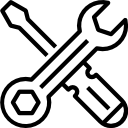Questions & Answers
There are many questions about installing a hydro pellet stove. We've compiled the most frequently asked ones in this article.
For example:
- Can a pellet stove and a boiler coexist?
- What is a hydro pellet stove?
- How to connect the hydro stove to the existing heating system?
- Where to install a hydro stove? How much power will I need?
There are, of course, technical conditions that need to be verified during an on-site inspection, as every home is unique and requires precise study, but some guidelines can apply to everyone. Let's look at them one by one.
Can a Pellet Stove and a Boiler Coexist?
Absolutely yes.
Many people who choose a hydro stove also have a boiler installed in their home. It can be useful in emergencies ("help, the pellets are out!") or to provide domestic hot water.
Those who choose more powerful hydro stoves often don't use the boiler at all during the winter, as the stove completely replaces it for both space heating and domestic hot water.
What Is a Hydro Pellet Stove?
Hydro pellet stoves (or hydro stoves) are pellet-fueled heat generators that can be connected to the home's plumbing system to deliver hot water to radiators.
The hydro stove can be referred to in various ways, all indicating the same thing: hydro stove, water stove, thermal stove, or even stove boiler.
How to Connect the Hydro Stove to the Existing Heating System?
This is a technical matter. The operation should be performed by a professional. However, here's how it works.
This particular type of stove must be connected to the hydraulic manifold; in this way, the stove can heat the water in the radiators, integrating or replacing the boiler's function.
This feature is important in terms of energy savings: a hydro pellet stove uses heat to warm water through a heat exchanger, which is then introduced into the radiator circuit. Such a stove can be useful, for example, to bring the entire system to temperature, an operation that requires significant energy expenditure from a traditional boiler.
A hydro pellet stove can also be effectively utilized by installing a buffer tank: an insulated tank that allows the storage of hot water produced, so it can be used as needed, even when the stove is not in operation.
Where to Install a Hydro Stove? How Much Power Will I Need?
Who better than a specialized technician can provide the answers you're looking for! Relying on expert personnel is the optimal solution when designing a system with a hydro pellet stove.
The technician will first provide consultation, then conduct an on-site inspection where all technical/functional aspects related to the stove will be carefully evaluated based on the home's characteristics, the state of the systems, and living needs.
Conducting an on-site inspection with expert personnel is essential to accurately assess all possibilities and issues regarding installation. At this stage, the technician will determine the necessary power based on the volume to be heated, the characteristics of the existing heating system, and whether the hydro stove can completely replace the boiler or if it's better to opt for an integrated support system.
During the inspection and design phase, it's very important to carefully evaluate the position where to install the hydro stove, to perfectly integrate this appliance into the domestic environment, allowing for optimal use.
Once the technical aspects are clarified, you obviously need to also consider the aesthetic ones. Unlike the boiler, the hydro stove will have a place of honor in the home, so it's better to choose it carefully. Thanks to new augmented reality technologies, you can see the stove directly in your home!
Augmented reality applied to the design phases is a valuable aid because it allows you to have a precise idea of how your home will look after installation, making it easier to choose the design and finishes that best suit your taste and home.


